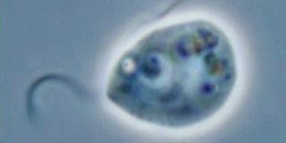| ISSUE 02/2011 01 Events + Featured 02 Physicists Strike Gold 03 The 'Model Behaviour' of Nano-Structures 04 'David and Goliath' Viruses Shed Light on Jumping Genes 05 Class Connections + Kudos |
 |
UBC Science Connect |
| NEWS AND EVENTS FOR UBC SCIENCE ALUMNI | VIEW HTML VERSION |

|
‘Superfish' Salmon Populations More Likely to Survive Climate ChangePopulations of Fraser River sockeye salmon are so fine-tuned to their environment that changes caused by climate change could lead to the disappearance of some populations, while others may be less affected, says a new study by UBC zoologists. UBC researchers studied eight populations of adult Fraser River sockeye and found that populations with the most difficult migrations were more athletic, displaying superior swimming ability and specialized heart adaptations. They also found that the optimal water temperature for a population matched the historical river temperatures encountered by each population on its migration routes. “This is the first large-scale study on wild fish to show how different populations of the same species have adapted to such specific migration conditions,” says Erika Eliason, lead author of the study. “As climate change alters the conditions of the Fraser River watershed, our concern is that some populations may not be able to adapt to these changes quickly enough to survive.” |


E-Natomy: How Digital Anatomy has Changed Medicine
Advances in the field of medical imaging have made it possible to look inside the human body with a precision previously unavailable without surgical exploration. Café Scientifique explores how radiology is changing medical practice.
Greater Vancouver Regional Science Fair Plasma Cell Development "Lost Ocean" in the Alps Evolution of Song |
 |

A Magnetic Personality: UBC Researcher Part of NASA Mercury Mission
A UBC geophysicist is part of a NASA mission that is unveiling the first images of Mercury taken from the planet’s orbit, and capturing new data on the tiny planet’s crust, topography and geologic history. Catherine Johnson, an expert in planetary magnetic and gravity fields, is part of NASA’s MESSENGER Mission’s geophysics group. Johnson, along with along with colleagues at Goddard Space Flight Lab and the Applied Physics Lab, is analyzing the initial data collected by the spacecraft’s magnetometer, which has measured Mercury’s magnetic field during 10 passes near the planet. “A team of scientists is working away on analyzing the data from MESSENGER’s instruments, all of which are now on and returning data,” says Johnson. “My group at UBC is working with the magnetic field, altimetry, and radio science data to try to understand the structure of Mercury’s internally generated field and how it interacts with solar wind.” “Over the next few weeks, the focus will be on collecting results from the early data as well as getting set up for a year of data collection and analysis,” says Johnson. “From what we’ve seen so far, it’s a very dynamic environment.” Want to know more about Catherine Johnson's work on the MESSENGER mission? Listen to her on CBC's Quirks and Quarks with Bob McDonald. |

Crash Course on Careers Needs Alumni Volunteers |
|

|
Wanted: alumni speakers! Come back and share your job search stories. Talk to current undergrads about the path you took from graduation to getting your first job. Share your tips on what employers are looking for in a resumé and what kinds of careers are available to someone with a science degree. Interested in participating? Please contact Kimberley Rawes. |

Physicists Strike Gold in Mineral Deposit Technology |
||
|
A new mineral exploration technology built on the research of UBC physicist Douglas Bryman has received $1.8 million in proof of concept funding from Western Economic Diversification.  |
 |
The technology, muon geotomography, relies on the detection of cosmic ray particles deep within the earth to create three-dimensional 'pictures' of dense ore deposits. The technology could increase the success of exploration while at the same time making it less expensive and reduce its environmental impact. "The underground muon sensor system is able to detect and differentiate regions of high density, from which 3D images can be created of potentially valuable ore," says Bryman, the JB Warren Chair at UBC Physics and Astronomy. |

Parents: Geer Up for Science Summer Camps |
|

|
Registration for UBC's Geering Up summer camps is open. The week-long camps mix science and technology demonstrations, hands-on projects, design competitions and labs for children in grades 2 to 10. |

Model Behaviour: UBC Researchers Can Predict Optical Properties of Nano-Structures |
||
|
UBC chemists have developed a new model to predict the optical properties of non-conducting ultra-fine particles that could help inform the design of tailored nano-structures. Aerosols and nano-particles play a key role in atmospheric processes and have become an increasingly important area of research.  |
 |
"Engineering complex nano-structures with particular infrared responses typically involves hugely complex calculations and is a bit hit and miss," says Thomas Preston, a researcher with the UBC Department of Chemistry. "Our solution is a relatively simple model that could help guide us in more efficiently engineering nano-materials with the properties we want, and help us understand the properties of these small particles that play an important role in so many processes." "Our solution is a relatively simple model that could help guide us in more efficiently engineering nano-materials with the properties we want." |

Parents: Sign Up your Kids for a Summer Tech Trek |
|

|
Registration for UBC's Computer Science Tech Trek summer camps is open. Your kids will take computers to a whole new level with a wide range of activities intended to excite, amaze, and teach. |

'David and Goliath' Viruses Shed Light on the Origin of Jumping Genes |
||
|
UBC Science researchers have identified a small virus that attacks another virus more than 100 times its own size, rescuing infected zooplankton from certain death in the process. The discovery provides clues to the evolutionary origin of some jumping genes found in other organisms.  |
 |
The study, by UBC marine microbiologist Curtis Suttle and PhD student Matthias Fischer, was published in Science. It describes the marine virus Mavirus and its interaction with marine zooplankton Cafeteria roenbergenesis and CroV, the world’s largest marine virus. "It’s a microbial version of the David and Goliah story where, after infecting Cafeteria roenbergeneis, Mavirus protects it against infection by CroV, while ensuring its own survival," says Suttle. |

UBC Science Likes You |
|

|
Visit us on Facebook and you can like us too! Connect with classmates, share stories and updates and discover what's new by checking out the UBC Science page on Facebook. We'll be posting news from the Faculty, as well as volunteer opportunities and event updates--and we promise never to tag you in any unflattering photos. |


Jamie Reimer, |
 |

Province Recognizes UBC Science Alumni for Community Service
Alia Dharamsi and June Lam, two young UBC Science alumni, have received 2011 BC Community Achievement Awards. Dharamsi was recognized for volunteer service at Canuck Place, tutoring and mentoring high school students, and developing a wellness conference for inner city youth. She also served as president of UBC's Meal Exchange program. Lam, cited for leadership, initiative, and enthusiasm, engaged in outreach work with the Faculty of Science's peer coaching team and the Let's Talk Science program, and co-chaired the 2010 UBC Student Leadership Conference. Both are among 36 recipients of the eighth annual BC Community Achievement Awards. Alzheimer’s Research, Evolutionary Biology Garner Killam Fellowships at UBC National Honours to UBC Researchers in New Materials, Atmospheric Aerosols UBC Computer Science Professor Wins Small Business BC Award |

 |
|

|
» 1988
A fluid experiment designed by UBC Chemistry's Don Brooks is activated and monitored by astronaut George D. Nelson on board Space Shuttle Discovery during a five-day mission, STS-26R. |

 | ||
You're receiving Science Connect because, as a UBC Science alumni or supporter, you've given the university permission to contact you. And while we hope you find our e-magazine interesting, we take your privacy seriously, and have made it easy for you to: | ||
 |
||

 |
| © 2011, UBC Faculty of Science | Privacy | Update your contact information |

